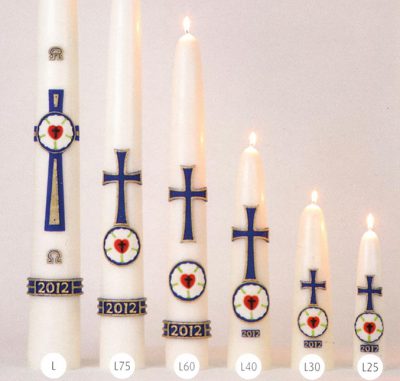We have designed several wax reliefs for specific religious orders, on this page you can view the details.
Our Lady of Guadalupe
Our Lady of Guadalupe (Spanish: Nuestra Señora de Guadalupe), also known as the Virgin of Guadalupe (Spanish: Virgen de Guadalupe) , is a Catholic title of the Blessed Virgin Mary associated with a Marian apparition and a venerated image enshrined within the Minor Basilica of Our Lady of Guadalupe in Mexico City. The basilica is the most visited Catholic pilgrimage site in the world, and the world’s third most-visited sacred site. Pope Leo XIII granted the venerated image a canonical coronation on 12 October 1895.
We have created this Lady of Guadalupe in wax relief. Completely made by hand of coloured wax with gold paint.
500 Years Reformation
500 Years of Evangelical Reformation 1517-2017
When Martin Luther posted his “Ninety-five Theses” on the church door in Wittenberg in 1517, no one expected the breadth of evangelical reforms in Christian teaching and practice that followed. In every dimension of Christian faith a renewed trust in God’s forgiving mercy replaced a reliance on teachings and practices that, like the sale of indulgences, were vulnerable to abuse and corruption.
Nearly 500 years later, the results of this evangelical confidence in God’s forgiving and liberating Word are evident today in Christian communities of all types.
We have designed two wax relief sets to use during celebrations or as a Paschal candle.
Lutheran Church
For the Lutheran religion, we offer two main designs: The Lutheran Rose and the Lutheran Swan.
The swan is a popular symbol of Martin Luther and is frequently found in Lutheran art. The history (or perhaps legend) behind the references to Luther as a swan are quite interesting. John Huss (1370-1415), whose name literally means “Goose” in the Bohemian language, was an important religious figure whose teachings stongly influenced Martin Luther and the Reformation. He was excommunicated and burned at the stake on July 6, 1415. So what does this have to do with Luther and a swan? The following is recorded by a priest observing the execution of Huss. Just prior to being burned at the stake, Huss was asked to recant his teachings. His response…
“You are now going to burn a goose, but in a century you will have a swan which you can neither roast nor boil.”
Almost exactly 100 years later, on October 31, 1517 Martin Luther posted his 95 Theses on the door of the Castle Church in Wittenberg.
Franciscan Order
Francis used the TAU in his writings, painted in on the walls and doors of the places where he stayed, and used it as his only signature on his writings.
The first recorded reference to the TAU is from Ezekiel 9:4, “Go through the city of Jerusalem and put a TAU on the foreheads of those who grieve and lament over all the detestable things that are done in it.” The TAU is the last letter of the Hebrew alphabet and looks very much like the letter “T”. With text Pax et Bonum (peace and the good) , Motto of St. Francis of Assisi and, consequently, of his monastery in Assisi; understood by Catholics to mean ‘Peace and Goodness be with you,’ as is similar in the Mass; translated in Italian as pace e bene.
We have designed a beautiful wax relief for candles regarding this item.






